
WASHINGTON – The number of Americans who identify as Christian has been declining for years, but that figure appears to be showing signs of slowing, according to a new Pew Research Center study released Wednesday.
According to the Religious Landscape Study, 62% of American adults identify as Christian. While this is a significant decline from 2007, when 78% of Americans identified as Christian, the Pew Center found that the percentage of the population that identifies as Christian has remained relatively stable since 2019.
According to the study, the rapid growth of people who do not identify with any religious faith has also stopped, now remaining at a temporarily flat level. About 29% of American adults identify as non-religious, including 5% atheists.
“It’s surprising to see this new period of stability in religious belief in America, after a long period of decline,” said Gregory Smith, one of the co-authors of the Pew Center study. “What we don’t know for sure is whether these short-term signs of stabilization will prove to be a lasting change in the country’s religious trajectory.”
In some ways, the United States continues to be largely spiritual. Many Americans hold views of the supernatural, with 83% believing in God or a universal spirit, and 86% believing that humans have souls. About 7 in 10 Americans believe in heaven, hell, or both.
Young people are less religious than older people
Despite this widespread trend of spirituality, there are also signs of a coming religious decline. The Pew Center study, for example, found a widening gap. 46% of young American adults identify as Christian, compared with 80% of older adults. Young people are also three times more likely than older age groups to not identify with any religious group.
“These kinds of generational differences are a big part of what has enabled the long-term decline in religious belief in America,” Mr. Smith said. “While entire generations of very religious people have passed away, they have been replaced by generations of younger people who are less religious than their parents and grandparents.”
Michele Margolis, a political scientist at the University of Pennsylvania who was not involved in the study, has examined how engagement with religion has changed.
Young people who reach adulthood often drift away from faith. “Then, when they get married and have children, that’s a time when researchers find that faith is more likely to become important,” Ms. Margolis said.
She says the question for the future is whether young Americans will firmly reject religious organizations, or whether some of them will return to faith as they age.
Pew Center data does not show that for the period 2007-2024, Americans have become more religious with age.
Mr. Smith says that “something has to change” to stop the long-term decline in faith in America, whether through the population becoming more religious as it ages, or with younger generations becoming more religious than their parents.
How politics and religious identity intersect
The long-term decline in Christian faith in the United States and the rise of the nonreligious are present across all segments of the population, regardless of tradition, gender, race, ethnicity, education and region. But according to the Pew Center study, the trend is much clearer among political liberals. The study shows that 51% of liberals do not say they belong to any religious faith, an increase of 24% compared to 2007. Only 37% of American liberals identify as Christian, down from 62% in 2007.
Penny Edgell, a sociologist at the University of Minnesota who served as an advisor for the Pew Center study, says religious and political positioning correlates with whether people “support traditional, patriarchal family and gender structures.”
Ms. Edgell also notes that African-Americans challenge the notion that all Democrats are less religious than Republicans.
“A higher percentage of African-Americans are Democrats, but their level of religious involvement is still really high,” Ms. Edgell said. “It has to do with the way religious institutions and politics have been intertwined in ways that are historically unique to different groups.”
Nearly 7 in 10 African-American Protestants told the Pew Center that faith was very important to them, about the same level as evangelicals and members of The Church of Jesus Christ of Latter-day Saints. But African-American Protestants are more likely to identify as Democrats (72%), while evangelicals and others are more likely to identify as Republicans (at 70% and 73%, respectively).
The Pew Center study also covers other faiths.
The previous study for the Religious Panorama was conducted ten years ago, with the aim of studying data not covered by the census in the United States.
The new study found that the majority of immigrants to the United States are Christian (58%), but that they also follow the same growing trend of non-involvement in religious organizations – a quarter of foreign-born young people already in the US say they do not belong to any religious faith.
The number of Americans belonging to other faiths has increased, although they are a small portion of the population (7%). This includes 2% who are Jewish and 1% who are Muslim, Buddhist and Hindu.
According to the Pew Center study, of American adult Christians, 40% are Protestant and 19% are Catholic. The remaining 3% include members of the Church of Jesus Christ of Latter-day Saints, Orthodox Christians, Jehovah's Witnesses and other smaller Christian groups.
According to the study, the two largest Protestant denominations continue to be the Southern Baptist Convention and the United Methodist Church – although both of these organizations have lost significant numbers of members since the first study was conducted in 2007.
The Pew Center's Religious Landscape Study was conducted in English and Spanish from July 2023 to March 2024, with a population sample of 36,908 people spread across the United States. The margin of error is estimated at plus or minus 0.8 percentage points./ VOA (A2 Televizion)











